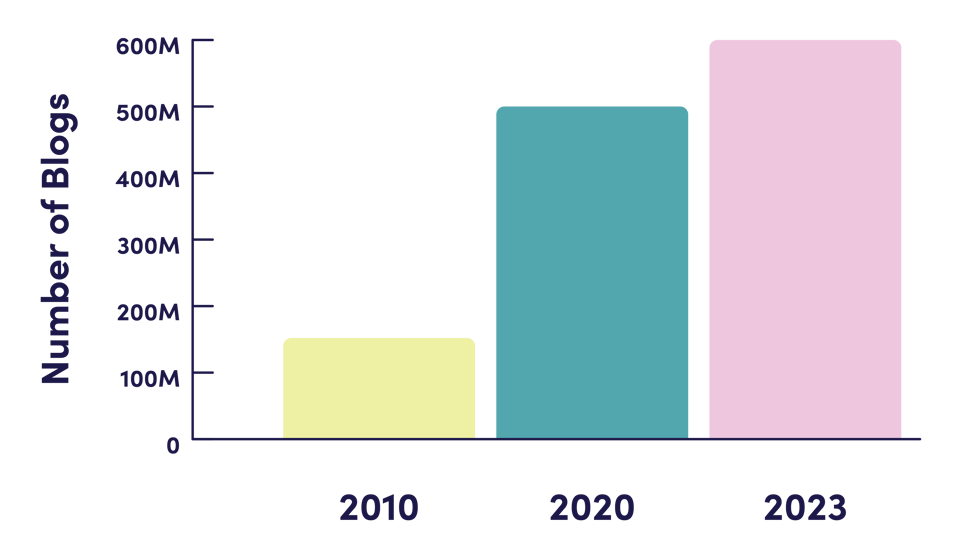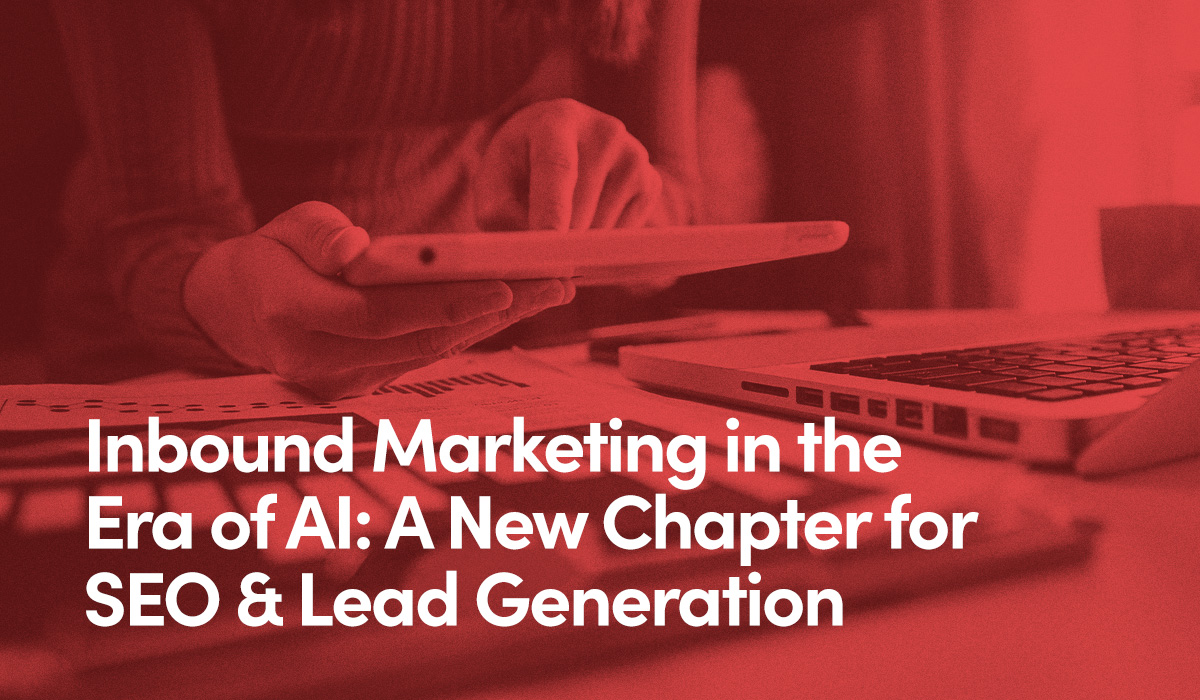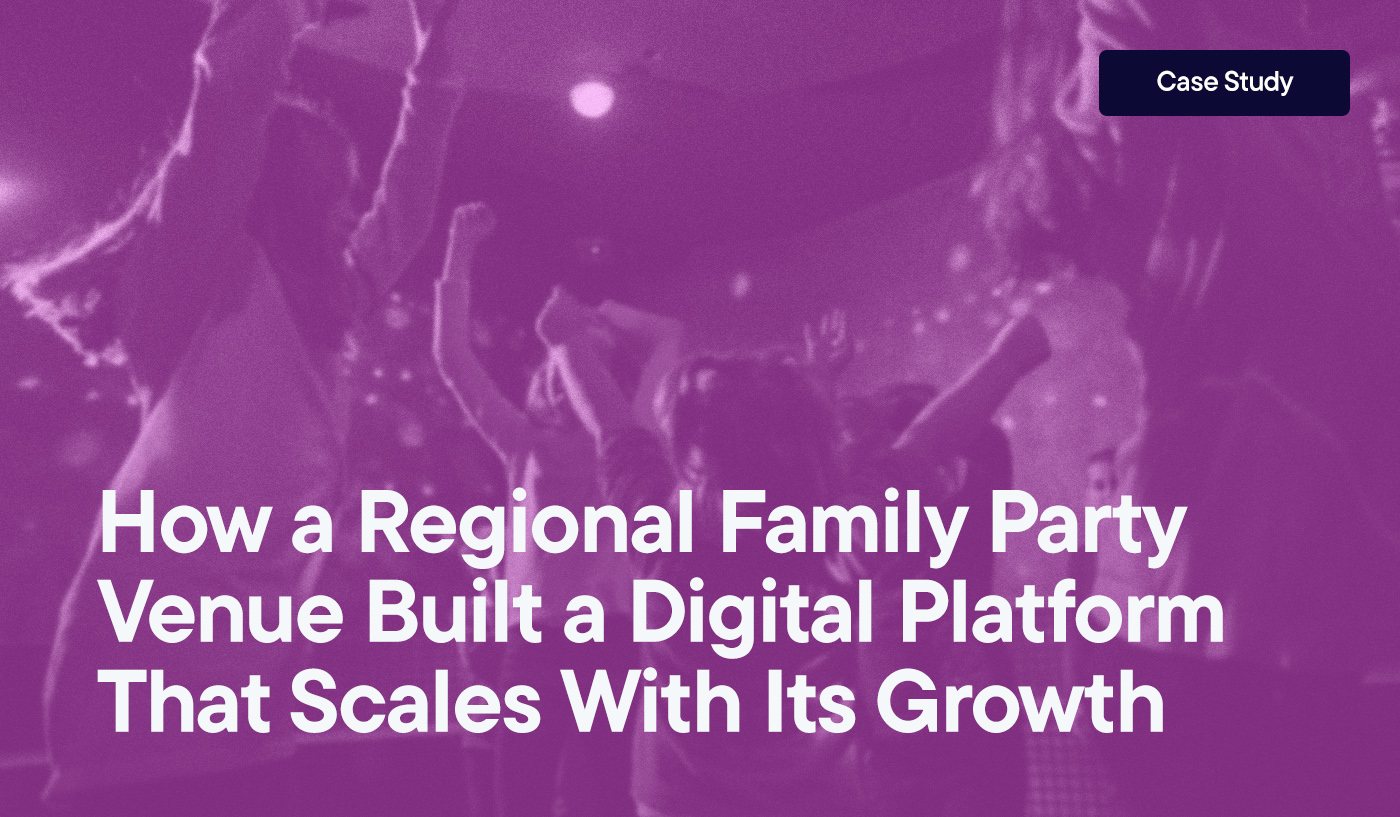The world of inbound marketing is constantly evolving, and to remain relevant, we, as inbound marketers, need to evolve along with it. As technology advances and user expectations change, so too must our approach. The latest developments in artificial intelligence (AI) are not only incredibly exciting, they’re also transforming entire industries.
For content marketers, especially, AI presents a unique opportunity to reinvent our strategies and embrace innovation in ways previously unimaginable. This goes far beyond assisting in content development. This evolution is poised to transform user experiences, open up new avenues for inbound marketers, and challenge the fundamentals of lead generation.
Welcome to the era of AI and the future of inbound marketing.
SEO Embraces Change
We love the future. In fact, we have a motto at Hypha HubSpot Development that perfectly reflects this: “The future is awesome.” This statement celebrates the constant advancements made possible by innovation and technology. Since the early days of inbound, Google has been the most important platform for marketers to master, and we’ve witnessed and adapted to its continual evolution—always with the goal of delivering the best possible search results for users. Understanding these changes is crucial for any inbound agency to ensure the content engineered achieves its intended goals: ranking organically and generating leads.
Several milestones in the SEO evolution throughout the years include:
- Focus on Content Quality: Creating high-quality, relevant, and informative content that provides value to the reader and helps establish authority and expertise in a particular topic.
- Proper Use of Keywords: Getting away from keyword stuffing and strategically utilizing keywords and phrases to communicate to users and search engines alike what a piece of content is about.
- Mobile Responsiveness: Ensuring a website is optimized for viewing on different devices including smartphones and tablets, and provides a good user experience.
- Topic Clustering: Organizing content into related topic clusters, which helps search engines better understand the semantic relationships between pages on a website and improves the site’s overall topical authority, leading to higher search rankings and enhanced user experiences.
- Metadata to Optimize Page Indexing: Implementing schema markup to help search engines better understand the content on a web page, including details such as its type, author information, and publication date.
- Mobile-First Indexing: A search engine optimization approach prioritizing the mobile version of a website over desktop for indexing and ranking, reflecting a corresponding shift in user behaviors.
- Accessibility Optimization: Making a website accessible to users with disabilities, such as those who use screen readers or keyboard-only navigation, to ensure everyone has equal access and functionality.
- Core Web Vitals: A set of metrics defined by Google that measures the loading speed, interactivity, and visual stability of a website, and used as a ranking factor in search engine results.
All of these concepts have been layered on over time to help Google find and deliver the best content for users—an approach that has seen the company capture an incredible 92.6% share of global search traffic across all devices.
So what’s next? Will generative AI tools such as ChatGPT upend Google’s reign and replace search? Will Google—or a competitor—learn to harness AI effectively to augment their current offerings? Or might AI’s current promise simply be a flash in the pan?
While it’s challenging to predict the future, it’s not impossible when bits of it are appearing all around us. Generative AI, the technology this piece addresses—which generates content, as opposed to predictive AI, which utilizes machine learning to forecast future events—is revealing some incredible opportunities for content creators, and we are once again preparing to adapt and harness these tools to meet users with high-quality information wherever they are, and whenever they need it.
How Other Agencies Are Looking at AI for Content Marketing
Many agencies are exploring the use of AI to enhance their content marketing strategies or add content marketing as a service where it was not previously offered. While AI has shown great potential in generating content quickly, it is essential to understand that the quality of the content produced by AI alone may not meet the standards expected by clients and users.
Without a clear understanding of its limitations (and the risks involved), AI should not be used without proper guidance. With that in mind, here are a few ways AI can support content marketers:
- Compose Original Content: AI can help create introductions, conclusions, or summaries, blog or pillar page outlines, or even entire drafts to be used as starting points.
- Identify Topic Gaps in Content Plans: AI can discover related topics that haven’t been covered yet, helping marketers stay ahead of the curve.
- Draft Marketing Emails: AI can craft promotional emails for landing pages or content offers, streamlining the email marketing process.
- Suggest Email Subject Lines for A/B Testing: AI can provide an array of subject lines to test—optimizing open rates and engagement.
- Write Social Media Posts: AI can create promotional content for social media platforms, including relevant hashtags and influencers to mention for increased visibility.
Overall, AI will continue to improve and increasingly become a valuable tool for content marketers, helping them produce more in less time. As we perfect our use of this technology, we expect dependance on it will only grow.
Currently, there is an AI arms race of sorts engulfing the marketing industry. Everyone is scrambling to leverage the technology to produce more and more content—without quality controls in place. In some cases, marketing agencies are laying off writers, only to find that the decision was premature.
The bigger question to ask is: What happens next? How do AI engines produce content relevant to your brand when they’re simply drawing from rehashes of pre-existing content—with no guarantees of quality, sourcing, or whether that content itself was written by AI?
The answer is that the brands that stand out in the future will be those that can feed AI, not simply regurgitate its unfiltered responses.
How We Are Thinking About AI for Content Marketing
We are excited. The power of AI enables content marketers to enhance their strategies, provides incredible insights, streamlines development, and supercharges workflows. However, the bigger opportunity lies in the websites that house this content and ways users find and interact with it.
User Expectations Are Changing
With more and more consumers incorporating ChatGPT and other AI-powered search bots and engines into their daily routines to create quick and conversational content and products, it’s inevitable the vast majority will form a preference for AI experiences. The primary driver of this shift in UX will be search engines, with Microsoft’s Bing chat experience and Google’s upcoming Search Generative Experience (SGE) leading the way. Rather than relying on traditional search engines to provide links that must be clicked to find more information, chat search results serve immediate, conversational answers.

The web is already inundated with content, sometimes making it difficult to stand out. Imagine what the proliferation of content due to generative AI obliterating the barriers of time and effort is going to do to that.
In truth, we don’t need more content! We need higher-quality content!
Chat Accuracy & Integrity
In order for chat-based search results to be fully adopted, users will require citations, along with links to where the information came from. Generative AI’s tendency to fabricate facts and sometimes “hallucinate” has raised some concerns—thus the need to verify the content it generates is very real. By including links to a chatbot’s sources or credible articles supporting them, users can be assured of the accuracy of the information. Bing has already taken steps to incorporate such citations in its conversational responses, and this presents an incredible opportunity for brands to demonstrate their authority in their given fields.
Opportunity for Inbound Marketers
Inbound marketing is a customer-centric approach to marketing that attracts, engages, and delights prospects by providing valuable content and experiences, rather than interrupting them with irrelevant messages. The primary tool inbound marketers leverage is content, written to either attract web traffic, convert that traffic into leads, close those leads into customers, or delight those customers so they become advocates. All of these stages are important, but the first—attracting visitors—is arguably the most challenging and most critical. This has long been described as “getting on the first page of Google.”
An inbound marketing agency is only as good as its ability to grow organic traffic. The closer you can get to the top result on the first page of Google, the more traffic a piece of content will generate. Search users are given the option to select one of 10 blue links, and their interactions validate to Google whether or not the result selected was indeed valuable.
But what happens when the chatbot simply gives the answer to the question?
A similar concern was raised when Google introduced knowledge graphs and so-called “position zero/0” results, answering the user’s question right at the top of its pages rather than sending them to an article providing an answer. While this might be bad for the content marketer, it is great for the user who might have simply been looking for a quick answer. Chatbots added to search engines present similar challenges. Users love getting answers quickly, and only questions that warrant deeper exploration will take them out of the search environment and into the greater internet.
The chatbot experience will not completely erase the need for those 10 blue links, however. If you are familiar with the chat search experiences Microsoft and Google are testing, you know there is room for both. Adjacent to the chat interface are legacy link results, enabling users to chat and then explore. In fact, the chat results will likely include links to where more information can be found—citations directly in the conversation. This is the new opportunity for inbound marketers. The new “first page of Google.” The new position zero. Be the chatbots’ citation!
So, how do we achieve this new ranking opportunity? To answer that, we need to revisit the impact these chatbots are having on user expectations. Addressing one will lead to the other.
Meeting User Expectations
As users become more comfortable with AI-powered chatbots, they will likely prefer, and become more dependent on this mode of communication. This raises questions about traditional blog environments. Do users want to sift through hundreds of articles that a company has published to find answers to their inquiries, or would they prefer to ask a question directly within the blog environment and receive a response drawn from a company’s library of content?
Conversational chatbots such as HubSpot’s Service Hub Chatbot integrate with a knowledge base and serve relevant support articles based on keywords. However, these chatbots are restricted by programming limitations and logic trees, which make them feel more akin to a phone directory than participants in a conversation. With AI-driven chatbots, we can overcome the limitations of these predetermined experiences—resulting in more intuitive and personalized experiences.
This is what’s next: AI-driven chatbots pulling answers from a closed blog or knowledge-base environment; Closed AI.
Closed AI is a type of generative AI that operates on a closed, predefined corpus of information. Instead of learning from the entire internet or a wide range of sources, a Closed AI system uses a specific, controlled knowledge base for its training and operation. This allows for a tighter control over the information the AI can leverage, potentially enhancing the accuracy, relevance, or safety of its outputs.
This is counter to OpenAI, a platform that leverages content from the general internet or an expansive range of data sources for its learning and operations. OpenAI uses these broad-based inputs to train its models, enabling them to understand and generate human-like text across a wide array of topics and contexts. However, this open-ended approach may also expose the system to a larger volume of unverified or diverse perspectives, which can be both a strength and a challenge in controlling the outputs.
Closed AI has several extraordinary benefits for businesses and users: The latter experience a human-free interaction with a company in a conversational format they prefer, with confidence it directly curates the responses from a pre-defined knowledge base (no more ‘ghost’ answers!). The former controls the information served, and can drive the conversation to the next logical step.
Chat results can link to full articles with more information, provide prompts for related next questions, and feed the database with queries the knowledge base should be answering.
Perhaps the best part: Optimizing content to be delivered in a private chat environment has the potential to optimize it for general AI-powered search conversations—whether you’re talking to Google, Bing, ChatGPT or another provider!>
Transform Your Business With AI Technology
Struggling to Keep Pace With the AI Revolution?
Discover Our Strategic AI Integration Solutions arrow_forwardArtificial Intelligence Optimization
The next milestone in SEO is AIO: Artificial Intelligence Optimization. AIO builds on traditional SEO, and prepares for the opportunities presented by this burgeoning technology. The behavioral shift AI presents fresh opportunities, but calls for inbound marketers to adapt their strategies in harmony with this paradigm. By embracing AIO, marketers can ensure their content is not only discoverable for users, but also compatible with the evolving algorithms employed by AI chatbots.
Strategic content optimized for AI should consider the following:
- Natural Language Processing: Clear and concise content that AI can easily comprehend and analyze—this means using simple language, avoiding jargon, and writing succinctly.
- Context-Aware Content: This takes into account the user’s context, such as location, device, and preferences, to provide personalized and relevant information.
- Conversational Tone: Content that feels like dialogue aligns with how users interact with chatbots in an authentically conversational way.
- Answer-Focused Content: This provides direct, concise answers to users’ questions and makes it easier for AI to extract and deliver information.
- Comprehensive Content Libraries: Create an extensive library of content covering a wide range of topics, questions, and user needs. This makes it more likely AI chatbots will find and cite your content when answering users’ queries. Use actual conversations and questions to inspire new content needs.
These are the core concepts for optimizing content for AI and AI-powered chatbot experiences. The technical side of AIO is a bit more complicated, evolving as quickly as ChatGPT models themselves.
Here are several key concepts of technical AIO to make content chatbot-ready:
- Content Processing: Clean and format your data for better processing. Remove unnecessary elements such as HTML tags, advertisements, JavaScript, or unrelated information.
- Split Content: Divide your content into smaller chunks to allow chatbots to efficiently process and find relevant information.
- Generate Embeddings: These mathematical representations of processed data enable efficient computation and comparison of text.
- Index Embeddings: Store the generated embeddings in an efficient and scalable search index. This will help chatbots quickly retrieve relevant content during user interactions.
- Open Indexed Embeddings: Create a public API that enables external chatbots to query your index. This should be designed with access control mechanisms and rate limiting to prevent abuse and unauthorized access, while encouraging open access to information.
Focusing on these optimizations helps ensure your content will be discoverable by AI, leading to increased visibility, higher search rankings, and ultimately, better user experiences.
The Future of Inbound Marketing
As we move forward in this new era, inbound marketing is set to undergo a significant and incredible transformation. AIO will become as critical to inbound as SEO has always been, and as with prior stages in their evolution, inbound marketers who successfully adapt will continue to pioneer the forefront of the industry.
Embracing AI in inbound marketing is not just about staying ahead of the competition; it’s about preparing for a future where AI is an integral part of the online user experience. By optimizing content for AI, marketers improve their chances of being accessed and served by it, increasing online visibility, and driving organic traffic in new ways.
And while the current revolution is powered by AI, we are confident new innovations are always on the horizon. As time advances, so too does technology, and marketers must adapt accordingly. The inbound marketers who keep an eye on the future and continuously evolve their tactics will be the ones who not only survive but thrive in the constantly changing digital landscape.
The future is awesome, and it’s now.
AI is a rapidly developing technology with huge implications—and opportunities—for businesses of all stripes. Uniquely positioned at the intersection of technology and business process development, the Hypha HubSpot Development team can help you leverage AI to streamline operations, gain valuable insights, and better serve your customers. Don’t get left behind. Contact us today to discuss an AI strategy tailored for your business needs.



